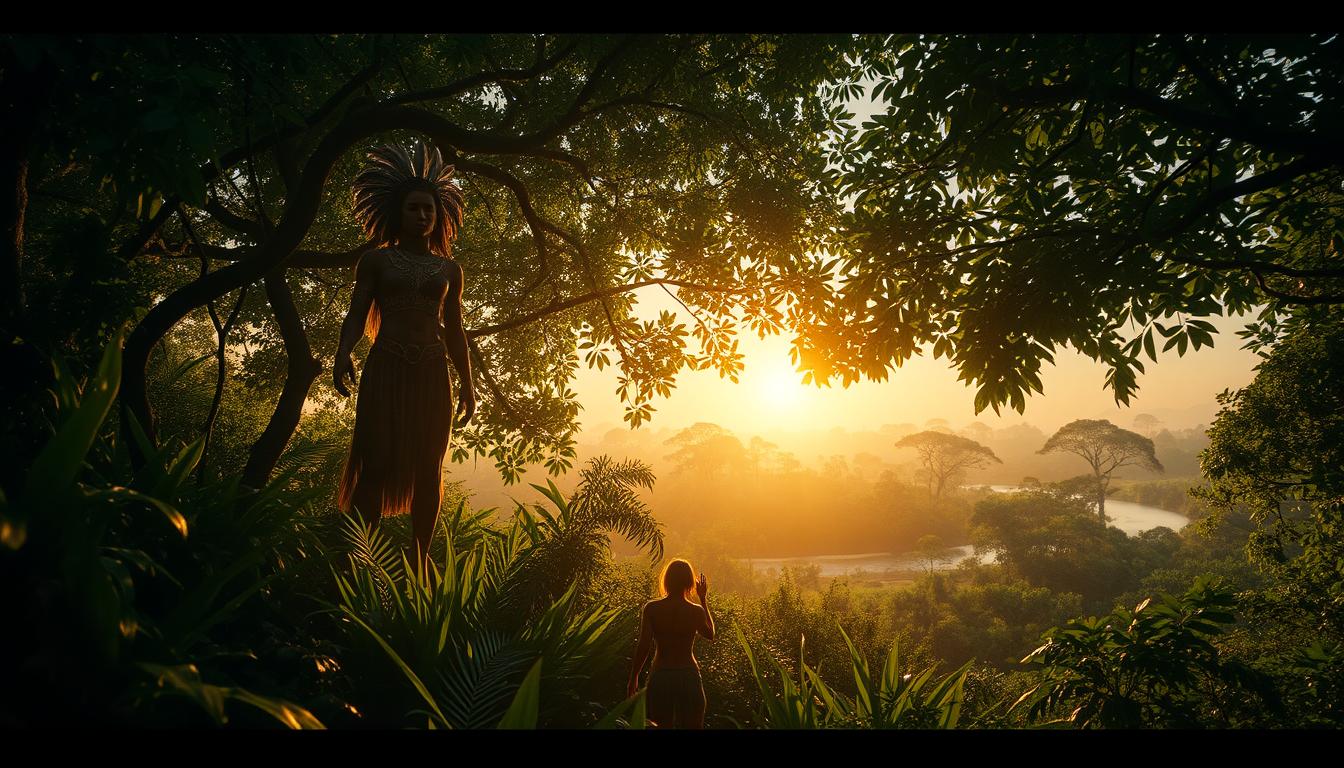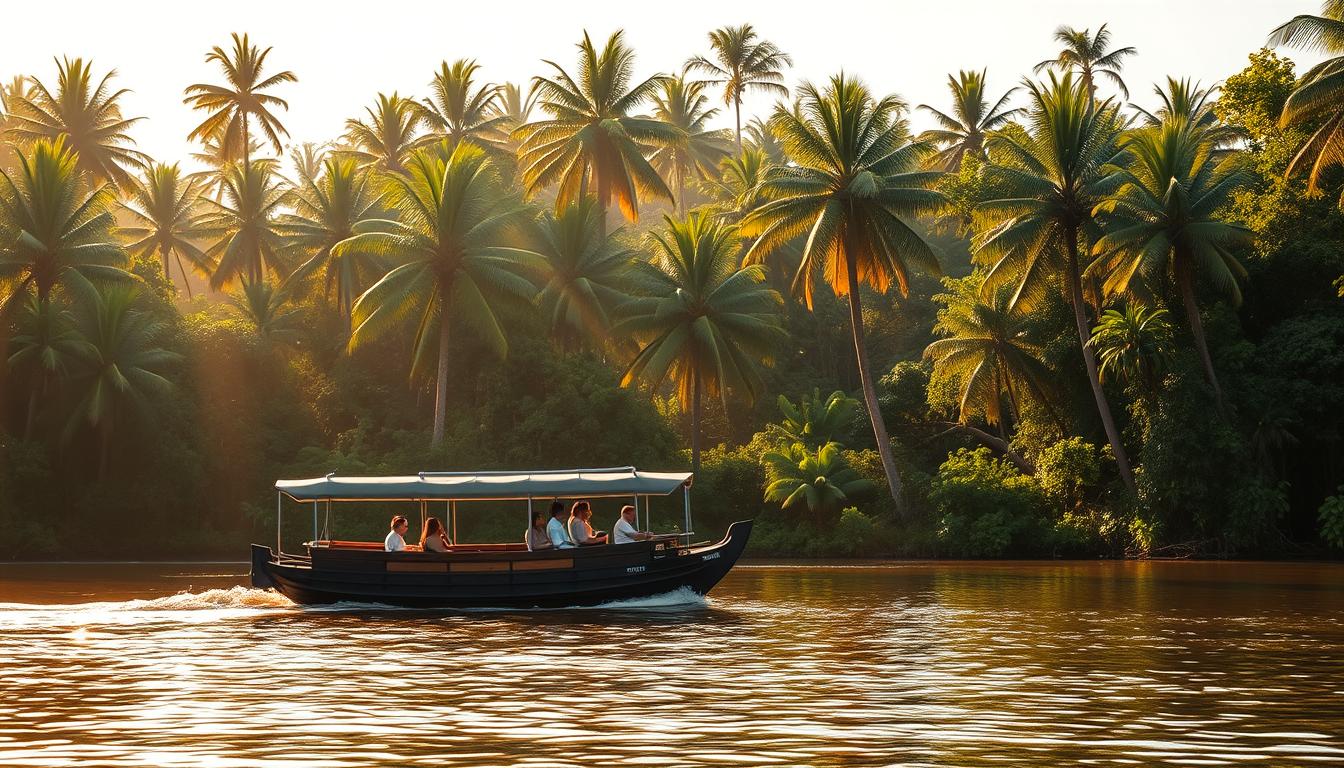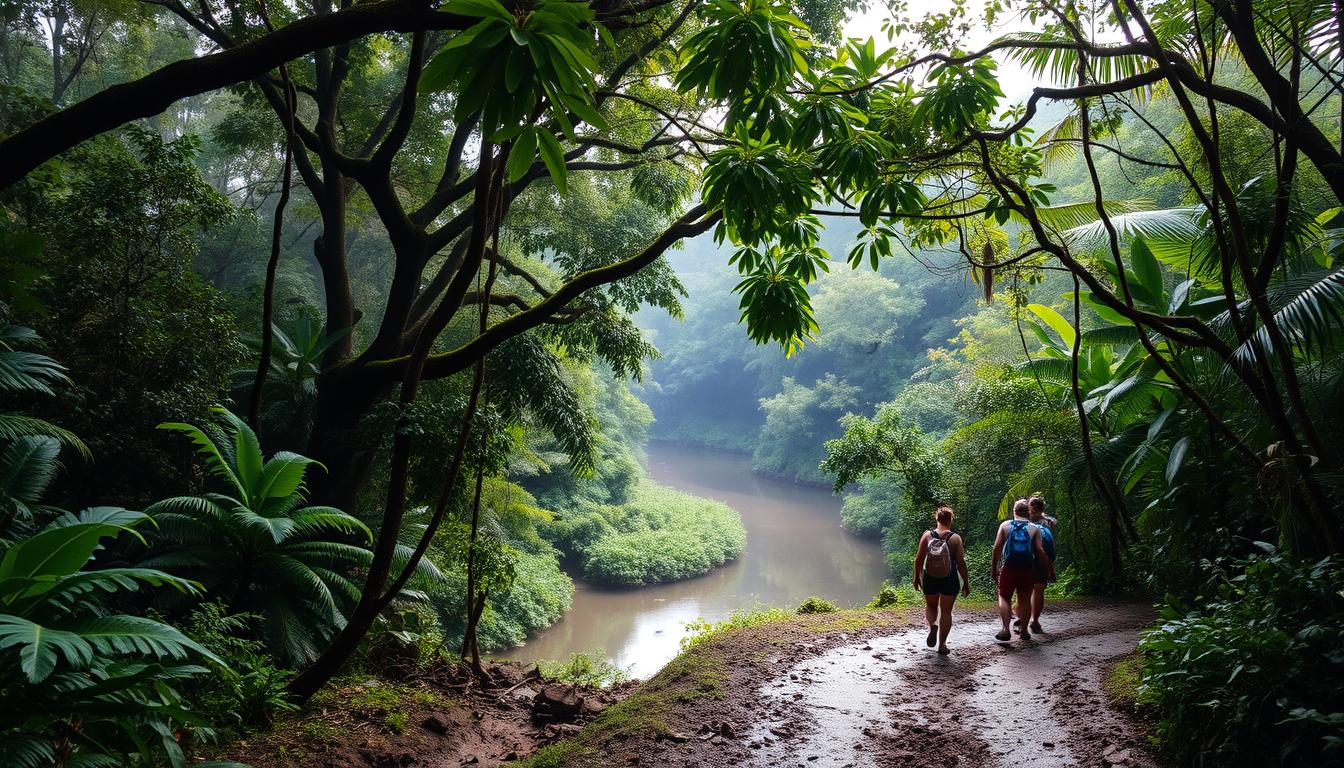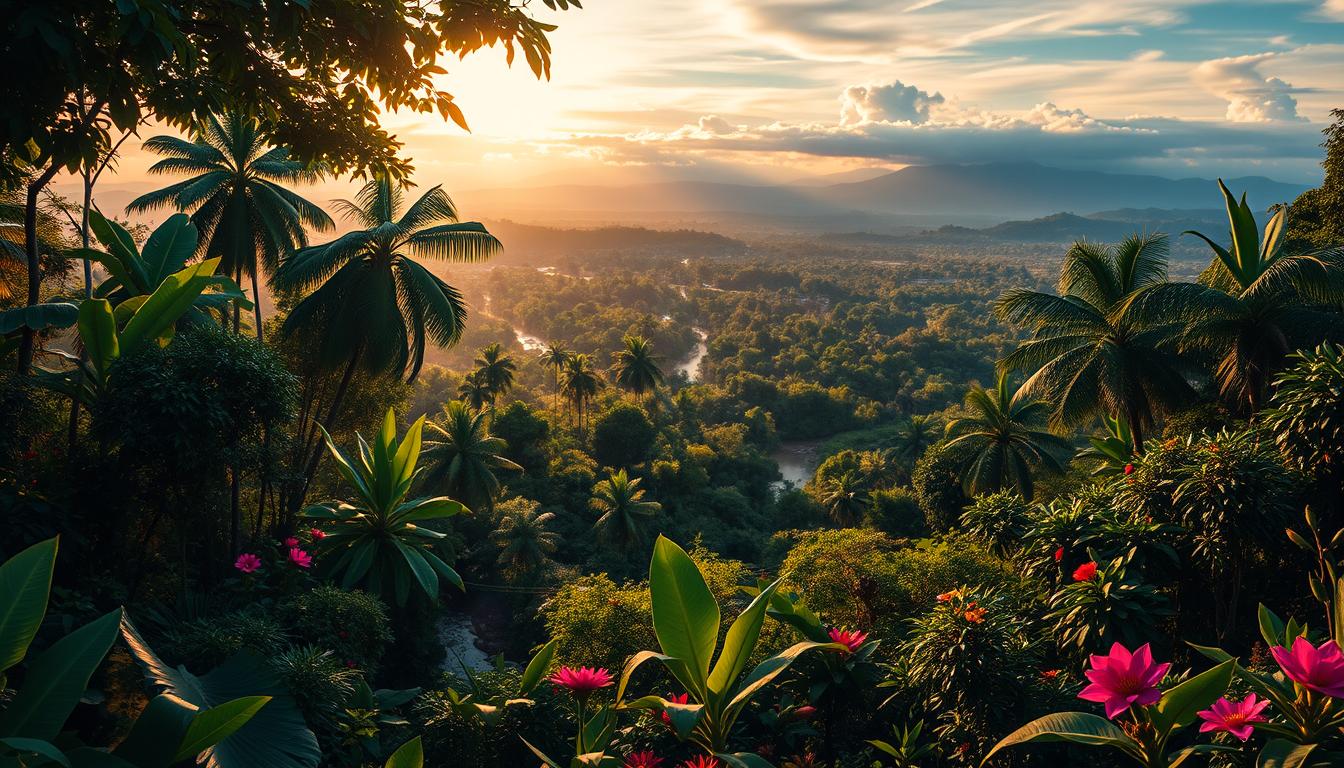Deep within the Amazon rainforest, a world of mystique and wonder awaits. The indigenous tribes have long shared stories of their ancestors, spirits, and the natural world around them, weaving a rich tapestry of Amazonian folklore. These indigenous stories are not just mere tales; they are a window into the cultural heritage and spiritual practices of the Amazonian people.
The Amazon rainforest is home to a diverse array of tribes, each with their unique myths and legends. Exploring these stories offers a glimpse into the intricate belief systems and the deep connection these communities have with their environment.
Key Takeaways
- Amazonian folklore is rich in stories of spirits and ancestors.
- Indigenous stories provide insight into the cultural heritage of Amazon tribes.
- The spiritual practices of Amazonian tribes are deeply connected to their natural surroundings.
- Exploring Amazonian myths and legends offers a unique perspective on the world.
- The diversity of Amazonian folklore reflects the complexity of indigenous cultures.
The Amazon Tribes and Their Cultural Heritage
The Amazon rainforest is home to a diverse array of indigenous tribes, each with their own distinct cultural heritage. These communities have thrived in the Amazon for centuries, developing complex societies that are deeply intertwined with their jungle surroundings.

Major Indigenous Groups and Their Territories
The Amazon is inhabited by numerous indigenous groups, including the Yanomami, Kayapo, and Tupi tribes. Each of these groups has its own language, customs, and territories within the rainforest. For instance, the Yanomami are known for their sophisticated agricultural practices and live in the borderlands between Brazil and Venezuela. The Kayapo, on the other hand, are renowned for their vibrant ceremonial attire and intricate body painting.
Some of the major indigenous groups and their territories include:
- Yanomami – Brazil and Venezuela borderlands
- Kayapo – Mato Grosso and Para states, Brazil
- Tupi – Various regions across Brazil
The Role of Oral Tradition in Preserving Tribal Knowledge
Oral tradition plays a crucial role in preserving the knowledge and cultural heritage of Amazon tribes. Through storytelling, myths, and legends, these communities pass down their history, survival strategies, and spiritual beliefs from one generation to the next. This rich tribal mythology is not just a form of entertainment but a vital means of preserving their identity and cultural practices.
“The oral tradition of indigenous peoples is a living, breathing repository of their history, culture, and knowledge.”
Connection Between Mythology and Survival in the Rainforest
The mythology of Amazon tribes is intricately linked with their survival strategies in the rainforest. Stories of jungle spirits and legendary heroes often contain valuable lessons on how to live in harmony with the environment. For example, tales of the Curupira, a mischievous forest spirit, teach the importance of respecting the forest and its creatures. This connection between Amazonian traditions and the natural world is a testament to the tribes’ deep understanding of their ecosystem.
By examining the cultural heritage of Amazon tribes, we gain insights into indigenous culture and the importance of preserving these rich traditions for future generations.
Legends from the Jungle: Myths and Spirits of the Amazon Tribes
The myths and legends of the Amazon tribes offer a fascinating glimpse into their spiritual beliefs and cultural practices. These stories, passed down through generations, are integral to understanding the tribes’ worldview and their connection with the natural environment.

Creation Myths of the Yanomami, Kayapo, and Tupi Tribes
The Yanomami, Kayapo, and Tupi tribes each have their own distinct creation myths that explain the origin of the world and their place within it. For instance, the Yanomami believe in a complex cosmology involving multiple heavens and a primordial forest. The Kayapo have myths that speak of the creation of humans and animals, emphasizing the interconnectedness of all living beings. The Tupi tribes’ creation stories often feature heroic figures who shape the world and establish the rules of nature.
These creation myths are not just stories; they are fundamental to the tribes’ understanding of their relationship with the environment and their cultural identity. They provide insights into the spiritual and philosophical beliefs of these communities.
Legendary Heroes and Cultural Icons
Legendary heroes and cultural icons play a significant role in the mythology of the Amazon tribes. These figures often embody the values and aspirations of the communities, serving as role models and sources of inspiration. For example, stories of brave warriors, wise shamans, and cunning tricksters are common, teaching important lessons about survival, morality, and the balance between humans and nature.
The narratives surrounding these heroes and icons vary among tribes, reflecting their unique cultural and historical contexts. However, they share a common purpose: to convey moral teachings and reinforce the social fabric of the community.
Animal Transformation Tales and Their Meanings
Animal transformation tales are another significant aspect of Amazonian mythology. These stories tell of humans transforming into animals or vice versa, often as a result of supernatural intervention or as a form of punishment or reward. Such tales serve to explain natural phenomena, the characteristics of certain animals, and the consequences of human actions.
These transformation stories also highlight the deep respect and understanding that Amazonian tribes have for the natural world. They underscore the belief in a shared existence between humans and animals, emphasizing the importance of living in harmony with the environment.
The Spiritual World of the Amazon
Deep within the Amazon, a complex spiritual landscape exists, filled with guardian spirits, river deities, and mysterious entities. The indigenous tribes of this region believe in a multifaceted spiritual world that is intricately connected to their daily lives and the natural environment around them.
Forest Guardians
The Amazonian tribes have a deep reverence for forest guardians like Curupira, a mischievous spirit known for protecting the forest and its inhabitants. Curupira is often depicted as a small, mischievous boy with bright red hair. Other protector spirits play crucial roles in safeguarding the forest’s resources and maintaining the balance of nature.

River Deities
River deities such as Boto and Yacumama are revered for their power over the rivers and aquatic life. Boto, a dolphin spirit, is believed to have the ability to transform into a human, while Yacumama, or “water mother,” is a serpent deity associated with the anaconda, symbolizing the fertility and danger of the river.
| Spirit | Association | Role |
|---|---|---|
| Curupira | Forest | Protector |
| Boto | River | Transformer |
| Yacumama | River | Fertility/Danger |
Dangerous Entities and Protection Rituals
The Amazonian spiritual world is not without its dangers. Entities that are considered malevolent or dangerous are believed to roam the forest and rivers. To protect against these entities, tribes perform various rituals, often led by their shamans, who are believed to possess the knowledge and power to communicate with the spiritual realm.
These rituals are crucial for maintaining harmony between the physical and spiritual worlds, ensuring the well-being of the community, and preserving the rich cultural heritage of the Amazonian tribes.
Shamanism and Spiritual Practices
In the depths of the Amazon jungle, shamanic practices have been preserved through generations, offering a glimpse into the tribes’ rich spiritual heritage. Shamanism is a cornerstone of the Amazonian tribes’ spiritual life, guiding their connection with nature and the supernatural.

The Pajé: Shamanic Traditions Across Amazon Tribes
The Pajé, or shaman, plays a vital role in the spiritual and communal life of the Amazon tribes. They are revered for their ability to communicate with the spirit world, heal the sick, and guide their communities through rituals and ceremonies. The Pajé’s knowledge and practices are passed down through generations, preserving the tribal folklore of the Amazon jungle.
Key responsibilities of the Pajé include:
- Performing healing ceremonies
- Conducting rituals to protect the community
- Interpreting dreams and visions
Ayahuasca, Rapé, and Other Sacred Plant Medicines
Ayahuasca and Rapé are sacred plant medicines that hold a central place in the shamanic practices of the Amazon tribes. Ayahuasca, a brew made from the Banisteriopsis caapi vine and other plants, is used in rituals to facilitate spiritual growth, healing, and communication with the spirit world. Rapé, a powdered snuff made from various plants, is used for clearing the mind, enhancing focus, and in healing ceremonies.
“Ayahuasca is not just a medicine; it’s a teacher, a guide that helps us understand ourselves and the world around us.” – A quote from an Amazonian shaman.
Healing Ceremonies and Communal Spiritual Experiences
Healing ceremonies are an integral part of the Amazon tribes’ spiritual practices, often involving the use of sacred plant medicines like Ayahuasca and Rapé. These ceremonies are communal events that bring together the tribe to support the healing process, fostering a sense of unity and shared spiritual experience.
The communal aspect of these ceremonies underscores the importance of tribal traditions in maintaining social cohesion and spiritual well-being. Through these practices, the Amazon tribes continue to preserve their indigenous myths and cultural heritage.
Conclusion: Preserving the Mythical Heritage of the Amazon
The Amazon rainforest is home to a rich tapestry of cultures, with indigenous communities that have lived in harmony with nature for centuries. The legends from the jungle: myths and spirits of the amazon tribes are an integral part of their identity, reflecting their deep understanding of the natural world and its rhythms.
The spiritual practices and mythical creatures of the Amazon tribes, such as the Curupira and Yacumama, are not only fascinating stories but also embody the communities’ connection with the land and their ancestors. These stories are a testament to the jungle spirituality that permeates every aspect of their lives.
Preserving the cultural heritage of these communities is crucial in the modern world. As we learn from the amazonian cultures and their mythical creatures amazon tribes, we are reminded of the importance of respecting and protecting the natural world. By embracing the diversity of indigenous cultures, we can work towards a more sustainable future.
The stories and spiritual practices of the Amazon tribes offer a unique perspective on the world, one that is deeply rooted in their connection with nature. As we move forward, it is essential to prioritize the preservation of their cultural heritage, ensuring that the legends from the jungle: myths and spirits of the amazon tribes continue to inspire and educate future generations.




